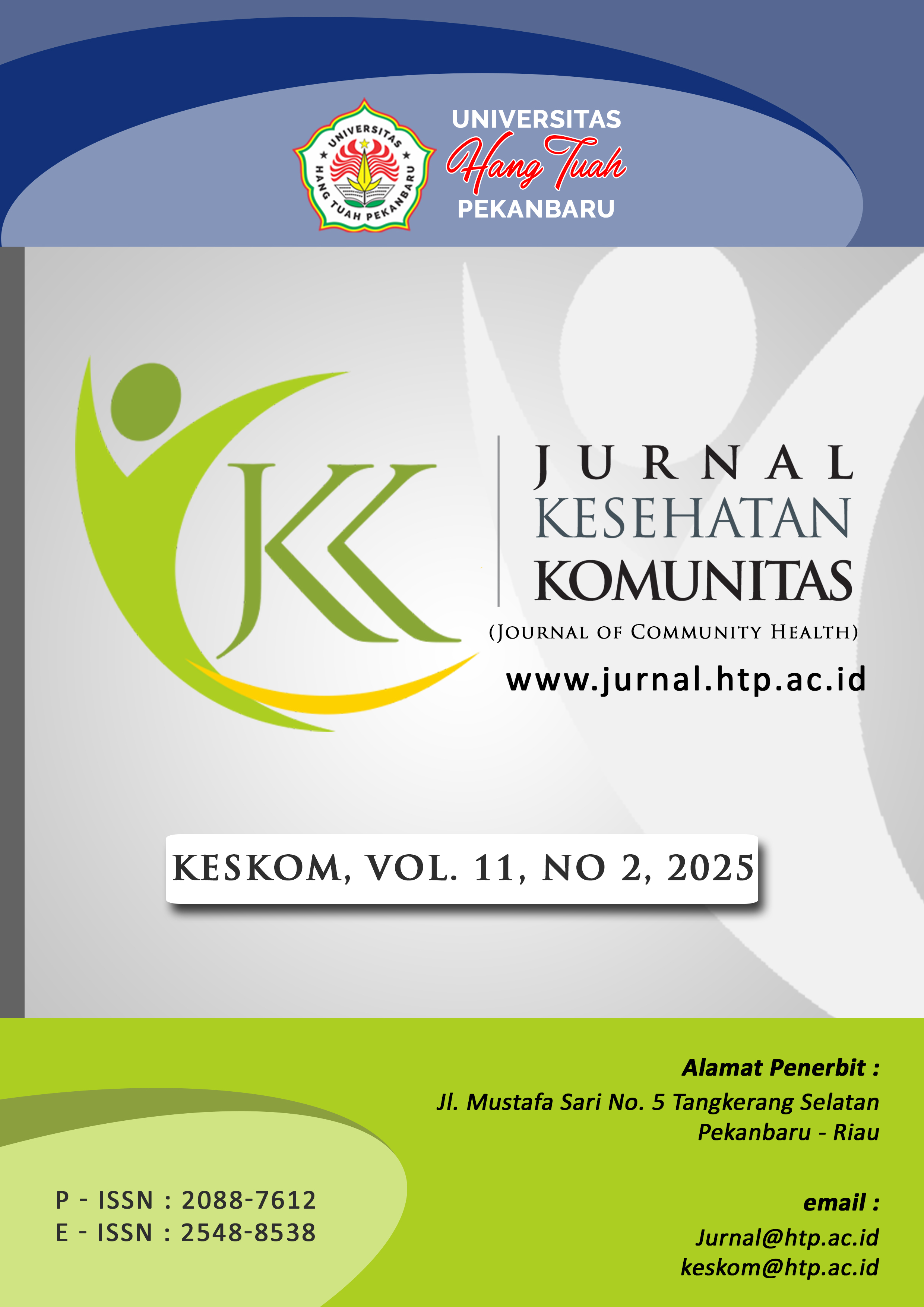Description of HIV AIDS Stigma among Primary Care Health Workers in Balikpapan East Kalimantan
DOI:
https://doi.org/10.25311/keskom.Vol11.Iss2.2170Abstract
The negative stigma towards PLWHA held by health workers makes people reluctant to take an HIV test because they are afraid of positive results and are worried about getting discriminatory services in primary health care. Stigma towards PLWHA occurs due to lack of knowledge about safe working methods in handling HIV/AIDS, homophobic attitudes, and religiosity. This study aims to describe the stigma and its determinants in health workers in Balikpapan City. The study design was cross-sectional. The population was health workers working in primary health care in Balikpapan City including general practitioners, nurses, midwives, pharmacists and laboratory staff. The population was 4284 people spread across 27 Health Centers in Balikpapan. The sampling type was quota sampling, calculated using the Lemeshow formula to obtain a sample size of 423. The instrument used to measure stigma was the Health Care Providers HIV/AIDS Stigma Scale (HPASS). Data analyzed using bivariat analysis. The results showed that most health workers still had a stigma towards PLWHA (53%). Individuals with the greatest high stigma were individuals who had never received HIV training (59.7%). Bivariate analysis showed that there was a relationship between stigma and HIV training (pvalue = 0.026). Regular training is needed on handling and assisting HIV/AIDS patients for health workers in Primary Health Care, in order to controlled the stigma.
Downloads
References
[1]. UNAIDS. Global Report 2023: The Path that Ends AIDS. https://thepath.unaids.org/wpcontent/themes/unaids2023/assets/files/2023_report.pdf
[2]. Kemenkes, R. I. (2022). Laporan Eksekutif Perkembangan HIV AIDS Dan Penyakit Infeksi Menular Seksual (PIMS) Triwulan II Tahun 2022.
[3]. James, T. G., & Ryan, S. J. (2018). HIV knowledge mediates the relationship between HIV testing history and stigma in college students. Journal of American College Health, 66(7), 561–569. https://doi.org/10.1080/07448481.2018.1432623
[4]. Hoffart, S., Ibrahim, G. M., Lam, R. A., Minty, E. P., Theam, M., & Schaefer, J. P. (2012). Medical students’ attitudes towards treating patients with HIV: a 12-year follow-up study. Medical teacher, 34(3), 254-254. https://doi.org/10.3109/0142159x.2012.652710
[5]. Rueda, S., Mitra, S., Chen, S., Gogolishvili, D., Globerman, J., Chambers, L., & Rourke, S. B. (2016). Examining the associations between HIV-related stigma and health outcomes in people living with HIV/AIDS: a series of meta-analyses. BMJ open, 6(7), e011453. https://doi.org/10.1136/bmjopen-2016-011453 PMID:27412106; PMCID: PMC4947735.
[6.] Fauk, N. K., Ward, P. R., Hawke, K.,& Mwanri, L. (2021). HIV stigma and discrimination: Perspectives and personal experiences of healthcare providers in Yogyakarta and Belu, Indonesia. Frontiers in Medicine, 8, Article 625. https://doi.org/10.3389/fmed.2021.625787
[7]. Hidayat, J., Miao-Yen, C. H. E. N., Maulina, R., & Nurbaya, S. (2023). Factors Associated with HIV-Related Stigma among Indonesian Healthcare workers: a cross-sectional online survey. Journal of Nursing Research, 31(5), e295. https://doi.org/10.1097/jnr.0000000000000573
[8] Wagner, A. C., Hart, T. A., McShane, K. E., Margolese, S., & Girard, T. A. (2014). Health care provider attitudes and beliefs about people living with HIV: Initial validation of the health care provider HIV/AIDS Stigma Scale (HPASS). AIDS and Behavior, 18, 2397-2408.
[9] Stangl, A.L., Earnshaw, V.A., Logie, C.H. et al. 2019. The Health Stigma and Discrimination Framework: a global, crosscutting framework to inform research, intervention development, and policy on health-related stigmas. BMC Med 17, 31. https://doi.org/10.1186/s12916-019-1271-3
[10]. Feyissa, G. T., Abebe, L., Girma, E., & Woldie, M. (2012). Stigma and discrimination against people living with HIV by healthcare providers, Southwest Ethiopia. BMC public health, 12, 1-12. http://www.biomedcentral.com/1471-2458/12/522
[11] Doda, A., Negi, G., Gaur, D. S., & Harsh, M. (2018). Human immunodeficiency virus/acquired immune deficiency syndrome: a survey on the knowledge, attitude, and practice among medical professionals at a tertiary health-care institution in Uttarakhand, India. Asian journal of transfusion science, 12(1), 21-26. https://doi.org/10.4103/ajts.AJTS_147_16
[12]. Langi GG, Rahadi A, Praptoraharjo I, Ahmad RA.2022. HIV-related stigma and discrimination among health care workers during early program decentralization in rural district Gunungkidul, Indonesia: a cross-sectional study. BMC Health Serv Res. Mar 17;22(1):356. doi: 10.1186/s12913-022-07751-7. PMID: 35300667; PMCID: PMC8932246.
[13] Katz, I. T., Ryu, A. E., Onuegbu, A. G., Psaros, C., Weiser, S. D., Bangsberg, D. R., & Tsai, A. C. (2013). Impact of HIV‐related stigma on treatment adherence: systematic review and meta‐synthesis. Journal of the international AIDS Society, 16, 18640. http://dx.doi.org/10.7448/IAS.16.3.18640
[14] Chambers, L. A., Rueda, S., Baker, D. N., Wilson, M. G., Deutsch, R., Raeifar, E.,T. S. R. (2015). Stigma, HIV and health: a qualitative synthesis. BMC public health, 15, 1-17.
[15] Aziz, M.M., Abdelrheem, S.S. & Mohammed, H.M. 2023. Stigma and discrimination against people living with HIV by health care providers in Egypt. BMC Health Serv Res 23, 663. https://doi.org/10.1186/s12913-023-09676-1
[16] Wilandika, Angga. 2019. Health Care Provider Stigma on People Living with HIV/AIDS (PLWHA) in Bandung. Jurnal Keperawatan, 10(1), pp. 7-14. https://doi.org/10.22219/jk.v10i1.6321
[17] Geter, A., Herron, A. R., & Sutton, M. Y. (2018). HIV-related stigma by healthcare providers in the United States: a systematic review. AIDS patient care and STDs, 32(10), 418-424. https://doi.org/10.1089/apc.2018.0114
[18] Tavakoli, F., Karamouzian, M., Rafiei-Rad, A. A., Iranpour, A., Farrokhnia, M., Noroozi, M., ... & Sharifi, H. (2019). HIV-related stigma among healthcare providers in different healthcare settings: a cross-sectional study in Kerman, Iran. International journal of health policy and management, 9(4), 163. https://doi.org/10.15171/ijhpm.2019.92
[19] Quan, M., Wang, X., Wu, H., Yuan, X., Lei, D., Jiang, Z., & Li, L. (2015). Influencing factors on use of standard precautions against occupational exposures to blood and body fluids among nurses in China. International journal of clinical and experimental medicine, 8(12), 22450.
[20] Ibrahim K, Wiwi. M., Ayu P.P. 2014. Pengetahuan, Sikap, dan Praktik Kewaspadaan Universal Perawat Terhadap Penularan HIV/AIDS. Jurnal Ners Vol. 9 No. 1 April 2014: 11–18
[21] Farotimi, A. A., Nwozichi, C. U., & Ojediran, T. D. (2015). Knowledge, attitude, and practice of HIV/AIDS-related stigma and discrimination reduction among nursing students in southwest Nigeria. Iranian journal of nursing and midwifery research, 20(6), 705-711. https://doi.org/10.4103/1735-9066.170011
[22] Vorasane, S., Jimba, M., Kikuchi, K., Yasuoka, J., Nanishi, K., Durham, J., & Sychareun, V. (2017). An investigation of stigmatizing attitudes towards people living with HIV/AIDS by doctors and nurses in Vientiane, Lao PDR. BMC health services research, 17, 1-13. https://doi.org/10.1186/s12913-017-2068-8
[23] Nyblade, L., Srinivasan, K., Mazur, A., Raj, T., Patil, D. S., Devadass, D., Ekstrand, M. L. (2018). HIV stigma reduction for health facility staff: development of a blended-learning intervention. Frontiers in public health, 6, 165. https://doi.org/10.3389/fpubh.2018.00165
[24] Attal, B. A., Al-Rowaishan, K. M., Akeel, A. A., & AlAmmar, F. K. (2021). HIV stigma in the teaching hospitals in Sana’a, Yemen: a conflict and low-resource setting. BMC Public Health, 21, 1-10. https://doi.org/10.1186/s12889-021-11845-y
[25] Veronica, R.R., dan Marselius S.T. 2022. Prasangka terhadap Homoseksual: Peran Fundamentalisme Agama dan Identitas Sosial, Jurnal Ilmiah. KELUWIH: Jurnal Sosial dan Humaniora, Vol.3(1), 40-49, April 2022, https://doi.org/10.24123/soshum.v3i1.5226
[26] Yuan, L., Peng, X., Wu, D. et al. Stigma toward people living with HIV among healthcare providers in midwifery hospitals in Shenzhen, China from 2020 to 2023. Sci Rep 15, 6677 (2025). https://doi.org/10.1038/s41598-025-91263-x
[27] Eaton, L., Driffin, D., Kegler, C., Smith, H., Conway-Washington, C., White, D., … & Cherry, C. (2015). The role of stigma and medical mistrust in the routine health care engagement of black men who have sex with men. American Journal of Public Health, 105(2), e75-e82.
Downloads
Submitted
Accepted
Published
How to Cite
Issue
Section
License
Copyright (c) 2025 Jurnal kesehatan komunitas (Journal of community health)

This work is licensed under a Creative Commons Attribution-NonCommercial-ShareAlike 4.0 International License.
Copyright @2017. This is an open-access article distributed under the terms of the Creative Commons Attribution-NonCommercial-ShareAlike 4.0 International License (http://creativecommons.org/licenses/by-nc-sa/4.0/) which permits unrestricted non-commercial used, distribution and reproduction in any medium












































